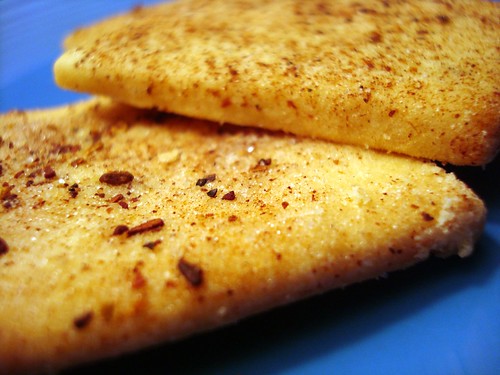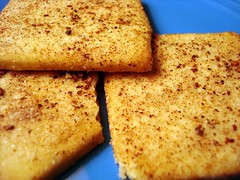
Before a few weeks ago, we had never even heard of the biscochito. But then, one of our spies had the good fortune of meeting with an extremely talented writer who hails from New Mexico (buy her books! here!); when we asked what baked goods were popular in the area, she mentioned this cookie. Intrigued, we tested out a recipe. We were instantly hooked by the taste--to us, it kind of tasted like a mexican wedding cake cookie crossed with pie crust and a melange of spices including anise and pepper--and eagerly set out to learn more about this magical cookie which has claimed the heart of New Mexico (in fact, it's their official state cookie). Let's get better acquainted with the biscochito, shall we?
 First off, what is a biscochito?
First off, what is a biscochito?
According to Miguel Hambriento, who wrote The Foods of Old Mesilla, they're "heaven's own little cakes blended delicately of sugar and spice, flour and wine and other secret ingredients, shaped by the swift fingers of the linda señora into small diamonds and baked until they are the delicate brown of the maiden's cheek kissed by the New Mexico sun".
What's up with this cookie's name?
Depending on where you look, it may be referred to as the bizcochito, biscochito or biscocho. There's a bit of debate over the name of these cookies. In general, it seems that they're referred to as biscochitos in the northern part of the state, biscochos in the southern part of the state. But wait, that's not all. In 1989, when New Mexico House Bill 406 declared the bizcochito as New Mexico's Official State Cookie, there was a battle over how to spell the cookie's name--biscochito or bizcochito. Several lawmakers got on the House floor to press for the "s" or "z". Eventually the Senate returned it as bizcochito.
 What's the story behind this cookie?
What's the story behind this cookie?
Biscochitos were introduced to Mexico by Spanish explorers in the 16th Century. In Spain they are called Mantecosos (according to our spanish dictionary, the word mantecosa means "buttery" in Spanish--love it). This cookie has long been associated with celebrations, sometimes being called the "Original Mexican Wedding Cookie", frequently served in a diamond shape to represent purity (just think about it--ew). Today, they make frequent appearances at weddings, quincenieras, baptisms and Christmas parties.
Are biscochitos hard to make?
 What should I drink with biscochitos?
What should I drink with biscochitos?We'll defer once again to the expert Hambriento, who says: "Biscochos go with vino like an egg on an enchilada". Sounds good to us, Hammie. OK, maybe milk or hot chocolate for the kids.
Biscochitos from a Trusted Source
- 1 lb lard (no substitutes!)
- 1 ½ cups sugar
- 2 eggs
- 2 tsps aniseed
- ½ cup sweet table wine
- 6 cups unbleached flour
- 1 Tbsp baking powder
- 1 tsp salt
- 1/4 cup sugar mixed with 1-2 tsp cinnamon for dredging
The next day, preheat the oven to 350º F. Have ready 2 ungreased cookie sheets.
Let dough stand at room temperature till soft enough to roll out; divide into quarters and roll to 1/8” thickness. Cut out with 2 ½”-3” cutter and bake 10-15 minutes, or until cookies are pale blond on top, golden on bottom. Sprinkle with sugar/cinnamon while still warm. Makes about 4-5 dozen cookies.